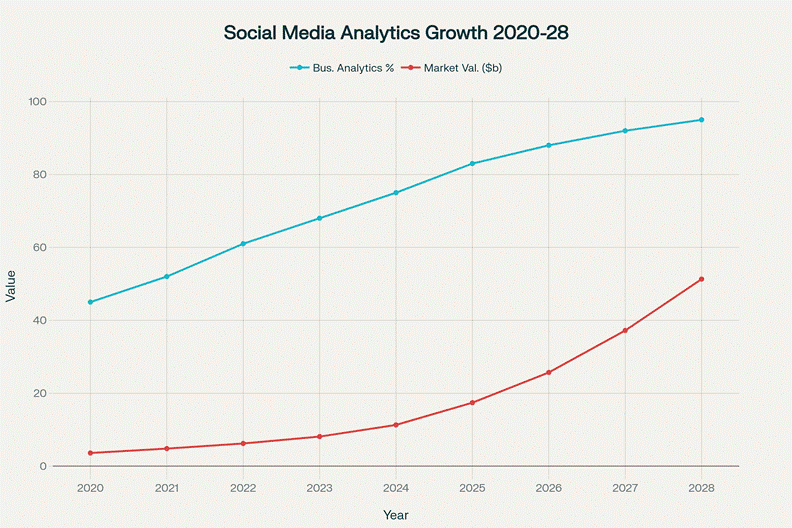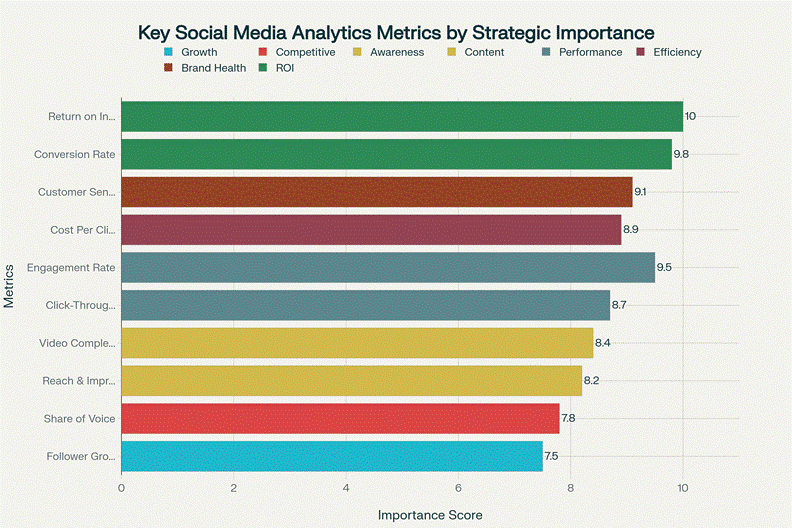Companies and brands are spending money on social media marketing while operating completely clueless about what performance metrics to look into. The result? Wasted budgets, frustrated marketing teams, and executives questioning social media’s actual value. Social media analytics isn’t just about tracking likes and comments anymore; it’s about connecting every rupee spent to measurable business goals. Yet most businesses use analytics like an afterthought, checking vanity metrics that look impressive in presentations but tell us nothing about profitability.
The difference between successful digital marketing campaigns and expensive mistakes often comes down to one factor: understanding what to measure and how to act on those insights. So, what is social media analytics in practical terms? It’s the systematic process of collecting actionable insights from social media data to optimise marketing strategies, improve customer engagement, and drive measurable business growth.

What is Social Media Analytics?
Social media analytics change the platform’s raw data into strategic intelligence that drives business decisions. Think of it as digital detective work, uncovering hidden patterns in customer behaviour, content performance, and market trends that traditional marketing methods simply cannot decode. The analytics landscape has evolved dramatically. Gone are the days when agencies could present monthly reports filled with impressive-looking graphs about reach and impressions. Today’s businesses demand accountability. They want to know exactly how social media activities contribute to lead generation, customer acquisition costs, and revenue growth.
Smart marketers now focus on 3 critical measurement layers: performance indicators (engagement quality, click-through rates, conversion paths), audience insights (demographic breakdowns, behavioural patterns, peak activity windows), and competitive intelligence (market share analysis, content gap identification, trending topic monitoring).
Here’s what most Social Media agencies in Delhi professionals won’t admit: measuring social media impact accurately requires connecting multiple data sources. Platform analytics tell only part of the story. Website analytics, CRM data, and sales metrics must work together to create a complete picture. The real challenge? When someone sees a Facebook ad, engages with an Instagram story, reads a LinkedIn article, and then purchases 3 weeks later through Google search, which platform deserves credit? This multi-touch journey creates measurement headaches that many businesses ignore entirely.
Successful analytics implementation demands moving beyond platform-specific metrics toward business-impact measurements. Revenue attribution, customer lifetime value tracking, and cost-per-acquisition analysis provide the insights executives actually care about.
Important Social Media Metrics for Brand Growth
Revenue-driving businesses focus on measurements that are actually related to profit margins and sustainable growth.
- Conversion rate optimisation sits at the top of every serious marketer’s priority list, and for good reason. A 2% conversion rate from social traffic can outperform 10% engagement rates that generate zero sales. Delhi’s competitive market demands this level of precision; businesses that track click-to-purchase journeys consistently outperform those obsessing over likes and shares.
- Customer acquisition cost (CAC) through social channels reveals campaign profitability better than any engagement metric. When acquiring customers costs ₹500 via Instagram versus ₹1,200 through Google Ads, the strategic choice becomes obvious. Smart businesses track CAC across platforms, then allocate budgets accordingly.
- Return on advertising spend (ROAS) separates profitable campaigns from expensive experiments. A 4:1 ROAS means every rupee invested returns four rupees in revenue, measurable, defendable, and scalable.
- Video completion rates, email sign-ups from social posts, and website session duration from social traffic provide actionable insights. These metrics connect social activities to business outcomes, creating clear pathways from content investment to revenue generation.
Most platforms highlight meaningless numbers to keep advertisers spending. Reach doesn’t pay bills. Impressions don’t increase bank balances. Brand awareness campaigns can’t sustain businesses indefinitely without conversion tracking. Smart marketers analyse comment sentiment, track profile clicks, and monitor story completion rates, signals that indicate genuine purchase intent.

Platform-Specific Social Media Analytics Implementation
Each platform requires different content strategies – understanding the crux of each platform can increase campaign effectiveness.
- Instagram analytics reveal fascinating consumption trends, particularly in Delhi’s diverse market. Stories consistently outperform feed posts for driving website traffic, yet most businesses ignore story analytics entirely. Carousel posts generate 1.4x higher engagement than single images, while Reels showing behind-the-scenes content typically achieve 3x better reach than polished promotional videos.
- LinkedIn’s professional context creates unique measurement opportunities. Article views translate to consultation inquiries at remarkable rates, sometimes 15-20% conversion from quality thought leadership content. Connection requests following engaging posts often indicate serious business interest, unlike casual social following elsewhere.
- Facebook’s mature advertising ecosystem provides sophisticated attribution modelling, but platform reporting can be misleadingly optimistic. Cross-referencing Facebook’s claimed conversions with actual website analytics frequently reveals 20-30% discrepancies. Smart marketers verify platform claims through independent tracking systems.
Here’s what analytics experts rarely discuss: platform algorithms deliberately obscure certain performance data to encourage increased ad spending. Instagram’s “reach” calculations exclude significant portions of actual content visibility. LinkedIn’s engagement metrics don’t account for passive content consumption patterns.
- YouTube analytics offer unparalleled audience retention insights – watch time percentages reveal exactly when viewers lose interest, enabling precise content optimisation. Businesses leveraging detailed watch-time analysis typically see 40% improvement in video performance within three months.
Cross-platform measurement requires connecting disparate data sources through UTM parameters, pixel tracking, and conversion path analysis. A Successful Social Media Agency in Delhi invest heavily in analytics integration, combining platform data with CRM systems to create a good customer journey mapping.
Also Read: The Ultimate Guide to Hiring a Social Media Agency in 2025
Getting Started Social Media Framework
Implementation begins with brutal honesty about current measurement capabilities. Most businesses discover their analytics setup resembles Swiss cheese – full of holes that leak valuable insights.
- Week 1st demands platform audit completion.
Review existing tracking systems, identify data gaps, and establish baseline measurements across all active social channels. Google Analytics integration often reveals shocking disconnects between social traffic claims and actual website performance. - Week 2nd focuses on goal alignment.
Revenue targets, lead generation quotas, and customer acquisition objectives should directly connect to social media KPIs. Businesses without clear connections between social activities and financial outcomes typically waste 40-60% of their marketing budgets. - The 3rd week’s implementation involves tracking system deployment.
UTM parameters, pixel installation, and conversion funnel mapping require technical precision; sloppy setup creates months of unreliable data. Professional marketers invest time up front rather than troubleshooting measurement problems later.
Monthly reporting cadences prevent analysis paralysis while maintaining strategic focus. Weekly tactical reviews combined with monthly strategic assessments provide an optimal balance between responsiveness and long-term planning. Tool selection matters less than consistent usage. Native platform analytics combined with Google Analytics provide sufficient insight for most businesses. Expensive third-party dashboards often create complexity without proportional value increases.
Success metrics vary by industry, but revenue attribution remains universally important. Businesses that cannot connect social media activities to financial outcomes struggle to justify continued investment, regardless of engagement statistics or follower growth rates.
Conclusion
Social media analytics separates profitable digital marketing from expensive guesswork. Businesses that master measurement-driven strategies consistently outperform competitors relying on intuition and vanity metrics.
Ready to transform your social media analytics approach? Savvytree specialises in data-driven digital marketing strategies that deliver measurable ROI for Delhi businesses. Our expert team connects social media activities directly to revenue outcomes, eliminating wasted ad spend and maximising campaign performance. Contact Savvytree today to discover how professional social media analytics can revolutionise your marketing results.
Related Posts
Top Benefits of Working with a Social Media Marketing Company in Delhi
Most D2C brands close within 24 months. The ones that survive? They stopped trying to handle social media themselves.Small businesses burn through marketing budgets on random Facebook ads and inconsistent...



